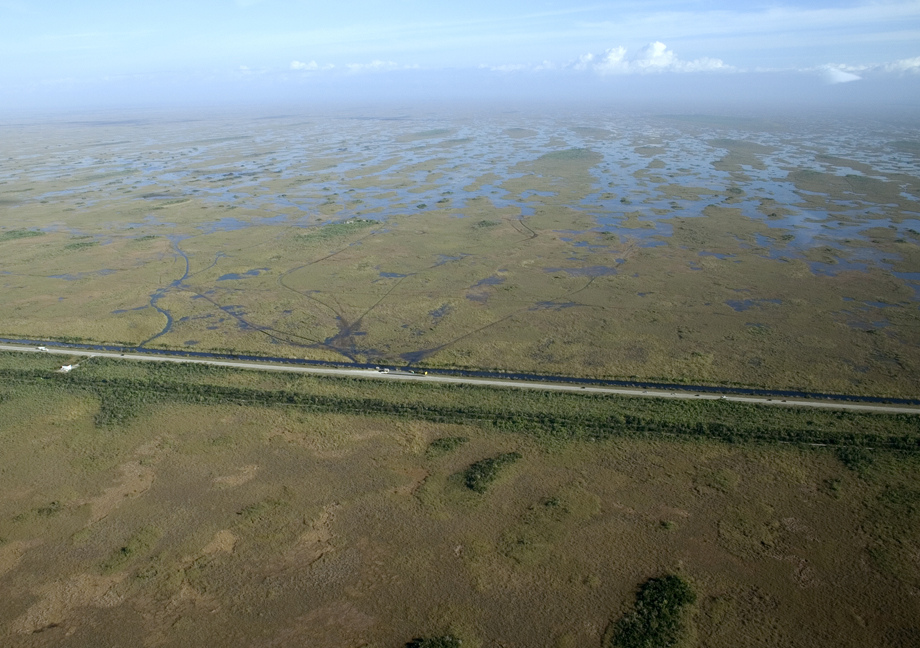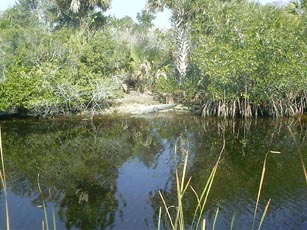
Snook out of season on the ‘Trail’ with an idiot. Centropomus undecimalis, common snook illustration by award winning artist Thom Glace. Used with permissions.
Please release me, let me go
By Skip Clement
Post snook season, late in May in South Florida, while on the *Trail, I happened on a fellow angler fishing a bridge. On the Trail, all the bridges have numbers. No, I’m not telling you the number on a bridge – that’s information hard-earned. I call it ‘Double-up.’
I watched a gent hook up from the opposite bank with a nice snook on a light-spinning tackle. He played the fish for over 8/9 minutes using the high-sticking pose on what had to be a loose drag. When he finally landed the exhausted +/- 6-pound snook, he lip held it perpendicular to the ground, without body support, thinking I was sure I’d ogle over the catch. Big smile included.

Looking North at Water Conservation Area 3a from Everglades National Park. Commons photo.
The snook was beating itself to death on the rocks
Now, several minutes out of the water, the snook got plopped on the rocks because of difficulty unhooking the Centropomus undecimalis with a treble bait hook.
Catching and killing just for the boast of it
A-hole then fumbled around to get his camera. It was now apparent that the snook wouldn’t live very long. He did put it back; he just kicked it into the water. It wiggled on its side a few times, attempting to right itself instinctively, but slowly floated away in stillness.
*NOTE: The Tamiami Trail is the southernmost 284 miles of U.S. Highway 41 from State Road 60 in Tampa to US 1 in Miami.
After the kill, I asked A-hole why he had taken so long to land the fish. Why had he held it by the lip without support? And why so long out of the water?
Post those queries, he became unruly, foul-mouthing me with a self-defining epithet: “You’re a F@#%&ing tree-hugging mother-fu…”
To which I replied, you just killed a beautiful fish, and I’ll bet you’ve killed a lot more in your lifetime just for the boast if that idiocy you just displayed was always in play.
Big chubby made like he was on his way across the bridge to engage until I jumped out of my car, slammed the door and made my way his way that out passed his aggression. Chubby pivoted and ran to his car, then took off leaving rod and reel behind. I left the spoils for the next angler.
Who do I think I am?
Thinking back on the situation, I shouldn’t have been so self-righteous – I should have kept my mouth shut. But then again, maybe I made a dent in the guy’s thick skull, I told myself.
So, the point is to be more mindful of reeling in the fish we catch and release. Shorten the fight, and take the photo-op with the fish in the water if possible. Don’t high-stick your rod. In that profile, a 12-weight wouldn’t budge a 7-pound item from the bottom of a swimming pool (Andy Mill did the test). Use proper landing nets; other kinds erase the slime that protects all fish from bacteria.

Tamiami Trail (US 41) about halfway between Miami and Naples, alligator far bank. Commons image.
And never lip-hold a fish, unsupported
NOTE: In Florida, the “Trail” is Tamiami Trail (built-in 1929) and is also designated as Florida Rte 41, a perilous east-west, two-lane road that connects Miami to Naples before turning north. On mostly the north side of the “Trail,” there are freshwater canals on the eastern portion that hold significant numbers of largemouth bass, and to the west, salt marsh tidal canals that hold snook, redfish, tarpon, jacks, mudfish, and exotics. Rte 41 also straddles Big Cypress National Preserve, Everglades National Park, Fakahatchee Strand Preserve State Park, several Miccosukee tribal communities, and Clyde Butcher’s Gallery (Tamiami Trail Mile Marker 54.5 – when open ). The latter is a very worthwhile stop.


